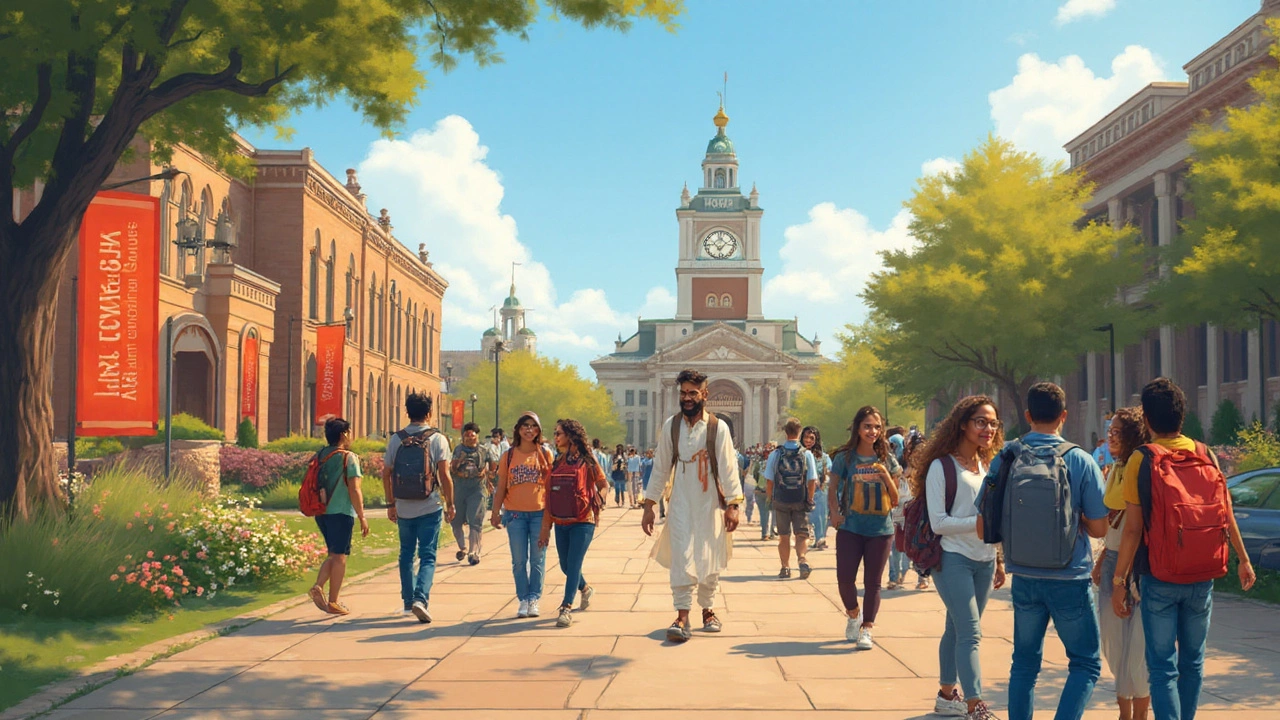Picture this: palm trees in Los Angeles, chilly sidewalks in Chicago, and college halls buzzing with students from every imaginable culture. The dream of earning a diploma in the USA is real, but the ride is nowhere near as simple as booking a flight and signing up for classes. Instead, it’s a wild mix of paperwork, planning, surprises—and lots of opportunity if you play your cards right. While Google makes it look as easy as adding items to a cart, there’s a winding road you’ll need to follow, and plenty of details that get missed out in those glossy brochures. Let’s get real on what it actually takes to secure a spot for a diploma in the USA, whether you’re eyeing engineering, graphic design, or culinary arts.
Understanding Diplomas in the USA: Types, Scope, and Popularity
First things first, the term “diploma” doesn’t always mean the same thing everywhere. In countries like India, a diploma may be a prestigious two-year technical qualification. In the U.S., diplomas are mostly seen as short-term, post-secondary programs—often less than two years—focused on hands-on skills or trades. Good examples: culinary schools, graphic design, automotive mechanics, practical nursing (LPN), massage therapy, or welding.
There’s also a distinction between diplomas and degrees. Diplomas are usually more career-focused, aimed at getting you job-ready. Associate Degrees and Bachelor’s are broader, academic, and typically needed for advanced or professional roles. To dodge confusion, most U.S. colleges clearly state whether a program leads to a ‘Certificate,’ a ‘Diploma,’ or a ‘Degree.’
The U.S. Department of Education recognizes many such programs, but not all colleges are created equal. Accreditation matters—a ton. Always pick a school that’s regionally or nationally accredited, otherwise your diploma could end up being just an expensive souvenir. According to a 2024 survey by the National Center for Education Statistics, over 500,000 international students enrolled in short-term courses in the U.S., and vocational diplomas accounted for 14% of these, showing their growing popularity.
Why are U.S. diploma courses attracting international students? The answer’s pretty clear: practical skills, better job chances, and that fancy American credential on your resume. Some colleges even claim job placement rates above 85% for graduates in specific trades. Plus, there’s the cultural side of things—learning in diverse classrooms, grabbing a taste of independence, and building a network that can take you places.
But not all diplomas are open to international applicants. For instance, some healthcare programs require certain state licenses that non-citizens may struggle to get. On the flip side, IT, culinary, design, and business-related diplomas tend to welcome more international students. Community colleges are a sweet spot too—they’re cheaper, often friendlier, and act as a gateway to the famous “2+2” transfer route into a U.S. university degree.
Let’s break that down with some real numbers.
| Diploma Course | Duration | Average Tuition (per year) | International Student Acceptance Rate |
|---|---|---|---|
| Graphic Design | 1 year | $10,000 - $15,000 | 78% |
| Practical Nursing (LPN) | 12-18 months | $12,000 - $20,000 | 57% |
| Automotive Technology | 1-2 years | $9,000 - $14,000 | 66% |
| Culinary Arts | 1-2 years | $14,000 - $18,000 | 82% |
| Business Management | 1 year | $11,000 - $15,000 | 74% |
There’s definitely variety, but keeping your eyes open for the right fit is everything. Choose your course based on interest and employability—don’t just follow the crowd or choose the cheapest option.
Eligibility and How to Pick the Right College
So, can you apply straight out of high school? For most U.S. diploma courses, yes, a high school diploma (12th grade) is the basic requirement. Some might want certain subjects—like basic science for nursing or computers for IT—but it’s generally not rocket science. Don’t expect entrance exams like the IIT JEE or NEET in most cases. Instead, they’ll look at your school transcripts, English ability, and sometimes a small personal essay or statement of purpose.
English is a big deal. If your last education wasn’t in English, most colleges will want to see a TOEFL or IELTS score. Typical cutoff? TOEFL 61-80 (Internet Based Test) or an IELTS score of 5.5 to 6, depending on the college. Some colleges offer their own English placement tests too, but a global certification opens more doors, no doubt.
Big tip: Don’t just Google “best diploma college USA” and apply to the first one you see. Pay attention to three areas:
- Accreditation: Check if the college is recognized by either regional accrediting agencies (like the Higher Learning Commission) or by specific national organizations for your trade.
- International Student Support: See if there’s a dedicated advisor, cultural events, and things like airport pickup. These details matter more than you imagine.
- Job Placement Services: Some colleges have partnerships with local companies or guaranteed internships—huge for anyone hoping to stay and work after the program.
Also, consider location. Want big city hustle or a quieter, more affordable suburb? The cost of living in cities like New York or San Francisco can double your total budget compared to smaller towns. And don’t ignore weather—Minnesota snow is unforgiving if you’re not used to cold.
Fees add up. There’s tuition, sure, but also books, health insurance, and admin costs. The real sticker shock is often with living expenses—average annual costs for an international student (including housing, food, transport, and insurance) can range from $12,000 to $20,000 depending on the state.

The Visa Drill: Requirements, Interview Hacks, and Survival Tips
This is where dreams often hit a wall—the F-1 Student Visa. To apply, you first need an admit letter and the SEVIS (Student Exchange Visitor Information System) I-20 Form from your chosen college. The real game is convincing the U.S. visa officer you’re a genuine student and not planning to overstay. It doesn’t matter how high your marks are if your documents (and body language) don’t add up.
What’s needed for the F-1 Visa? Typically:
- Valid passport
- Original college offer letter and I-20 Form
- Proof of funds (bank statements, affidavits, scholarship letters)—show at least the total annual cost
- School transcripts and English test scores
- Visa fee receipt and SEVIS payment receipt
- Visa application DS-160 confirmation
The interview freaks out a lot of students. Truth is, most consular officers just want honest, clear answers in decent English. They’ll ask about your college choice, why the U.S., how you’re paying, family background, and what you plan after graduation. Big mistake? Mumbling or sounding memorized—just be real. Secure funding (at least for the first year) and prepare for the question: “Will you return after your course?”
Some quick hacks:
- Dress smart, but don’t go overboard. Appearance signals seriousness.
- Arrive early and keep all documents in order—fumbling papers is a red flag.
- Be calm, maintain eye contact, and answer clearly.
About 23% of student visa refusals last year were due to “insufficient financial proof” or “unclear study plans.” So get your paperwork sorted, and rehearse your genuine story.
After your visa is approved, you can enter the U.S. up to 30 days before your class starts. You can work up to 20 hours per week on-campus. Off-campus work is only allowed in special cases and requires college and government approval—violating this is a surefire way to get your visa revoked.
Don’t expect freebies—scholarships for diploma-level international students are rare. But some community colleges do offer small grants or tuition waivers for strong applications. Use college websites to scout these deals instead of third-party agents making grand promises.
Life as a Diploma Student in the USA: Challenges, Culture, and Job Prospects
Stepping foot into a U.S. college is bewildering. You’re surrounded by unfamiliar faces, tiny cultural codes, and professors who call you by your first name—even if you’re used to the ‘sir/madam’ universe. Classroom vibes are casual, but expectations are real—show up, participate, submit work on time. Teachers will notice if you vanish from class or slack off in group projects.
Housing is a maze. Dorms are not as common for diploma programs; most students find shared apartments or homestays. Rent varies wildly—think $400 per month in Oklahoma to $1200 in Los Angeles for a shared room. Splitting costs with fellow students is the survival trick.
Culture shock is real, but so is the freedom. You cook your own food, juggle classes and laundry, and figure out practical stuff (like setting up a bank account or finding affordable groceries). American campuses celebrate diversity, so you’ll meet people from all over: Brazil, China, Nigeria, Saudi Arabia—you name it. Celebrate your culture, but keep an open mind.
On the money side, stretch that budget. Food, phone plans, health insurance, and local transport all nibble away at your savings. Many students grab on-campus gigs: library helper, campus café, or IT assistant. Remember—the 20 hours per week rule is strict. Don’t try double shifts under the table, no matter who suggests it.
Now, about jobs after your diploma. An F-1 student can apply for Optional Practical Training (OPT), which is up to 12 months of work in your study field. This is the real-world, hands-on experience you came for—and also a chance to earn back some of your investment. If you impress an employer who’s willing to sponsor you, there’s a chance to convert to an H-1B work visa later. But straight talk: it’s not guaranteed. Sectors with strong demand—like IT, healthcare, logistics, and hospitality—give you better odds.
Here’s one more stat worth remembering: According to U.S. Immigration data, about 43% of international vocational diploma students extended their stays for work via OPT in 2024. Another 35% returned home with upgraded skills and new job offers in their countries, often at higher pay grades.
Side tip? Dive into student clubs, career fairs, and local events. These aren’t just for socializing—they’re goldmines for networking, finding jobs, and getting recommendations. The more you put yourself out there, the better your personal and professional growth.
If homesickness hits, it’s normal. Call home, but don’t hide out. Most colleges have free or low-cost counselling and support groups—remember, every other international student has lived those same ups and downs.
So, can you go to the USA for a diploma? Absolutely—if you’re ready for the process, the paperwork, and some solid adaptation. The payoff: an American diploma, a transformed resume, and maybe a few lifelong friends from every corner of the globe.
